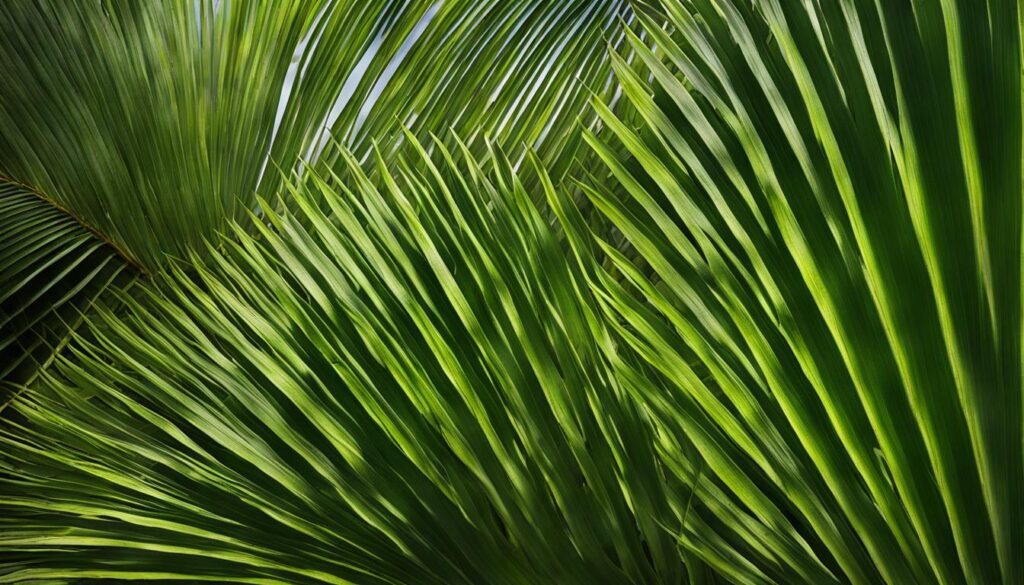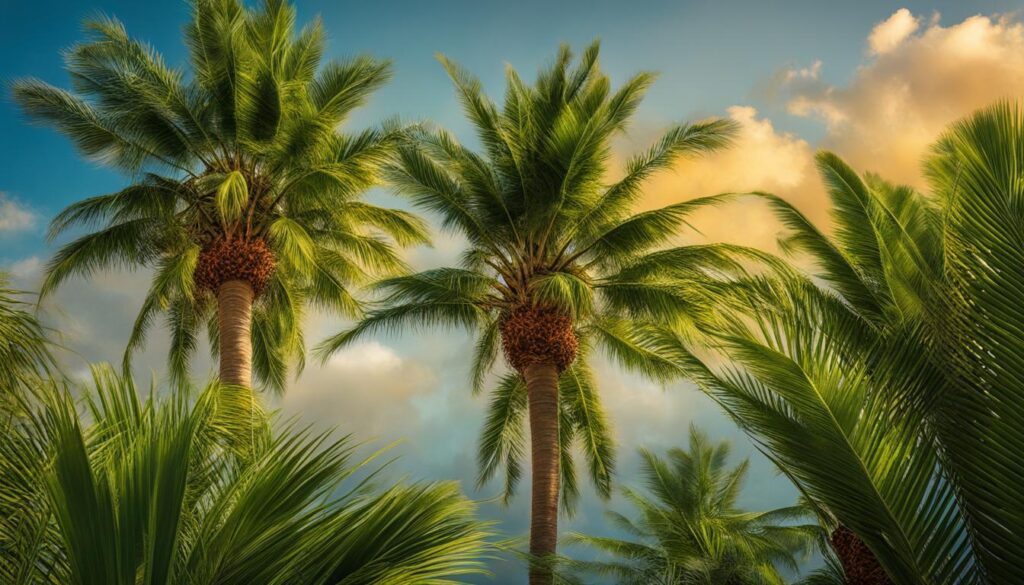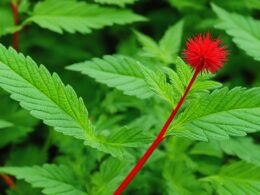Welcome to our comprehensive guide on palm trees! If you’ve ever wondered how long these iconic trees live, you’re in the right place. In this article, we’ll explore the fascinating world of palm trees, including their lifespan, diversity, and adaptability.
Palm trees, known for their tropical appeal and graceful appearance, have captured the imaginations of people around the world. But have you ever wondered how long these majestic trees can live?
The lifespan of palm trees can vary depending on several factors, such as the species and environmental conditions. According to Donald Hodel, an environmental and landscape horticulture advisor, many palm trees planted in Los Angeles before the 1932 Olympics have about 30 to 50 years left. While some palm species can live up to 150 years, the average lifespan of a palm tree is usually around seven to eight decades.
Diseases, environmental conditions, and maintenance practices also play a significant role in the lifespan of palm trees. It’s essential to understand these factors to ensure the longevity and health of these beautiful trees.
If you’re curious about the history, importance, and diverse characteristics of palm trees, keep reading. We have exciting information to share with you!
The History and Importance of Palm Trees in Los Angeles
Palm trees have a long and significant history in Los Angeles, playing a vital role in shaping the city’s landscape and identity. One of the most iconic species, the Mexican fan palm, was introduced to California by Spanish missionaries in the 18th century for religious purposes. These majestic trees quickly became a symbol of the region’s beauty and allure.
In the late 19th century, palm trees became central to the marketing efforts of real estate developers in Southern California. They believed that by lining the streets with these towering palms, they could attract people seeking a slice of paradise. The palm-lined boulevards became synonymous with the glamorous and desirable image of Los Angeles.
Palm trees gained even more prominence when thousands of Mexican fan palms were planted as street trees in preparation for the 1932 Olympics. This visual spectacle further cemented the association between palm trees and the allure of Los Angeles as a vibrant and glamorous destination.
While palm trees have undoubtedly contributed to the city’s aesthetic appeal, they have also faced criticism for their limited shade-providing capabilities. As temperatures continue to rise due to climate change and the palm trees age, there is a growing recognition of the importance of planting other drought-tolerant trees to increase shade availability in Los Angeles.
Despite these considerations, palm trees remain an integral part of Los Angeles’ identity, representing its history, charm, and cultural significance. Their presence continues to shape the visual narrative of paradise for residents and visitors alike.
The Diversity of Palm Tree Fronds
Palm tree fronds are a remarkable feature of these majestic trees. They exhibit a wide range of shapes, sizes, and colors, adding to the diversity and allure of palm trees. Some palm tree fronds are fan-shaped, which gives them a distinctive appearance. Others are feather-shaped, resembling delicate plumes. There are also fronds that have an entire shape, which means they are undivided and have a smooth contour.
The size of palm tree fronds can vary significantly. Some fronds are small, measuring just a few inches in length, while others can be several feet wide, providing ample shade and protection. These larger fronds make a grand and striking impression, enhancing the aesthetic appeal of palm trees.
The color of palm tree fronds is another fascinating aspect. Depending on the species, fronds can be brown, green, or gray. The natural hue of the fronds contributes to the overall beauty of the tree, blending harmoniously with the surroundings. Whether it’s the vibrant green of a healthy palm tree or the earth tones of mature fronds, each color palette has its unique charm.
Palm tree fronds serve a practical purpose in addition to their visual appeal. They are hardy leaves that provide shade and protection in various regions around the world. When the fronds naturally fall from the tree, they can be repurposed in several ways. For example, they can be used as kindling for fires, fed to livestock as nutritious fodder, or woven into handicrafts and useful products.
Identifying palm tree fronds can sometimes be challenging since different species may have similar frond characteristics. However, the diversity and versatility of palm tree fronds are undeniably captivating, reflecting the wide range of palm tree species found globally.
The Growth and Maintenance of Palm Trees
Palm trees have a unique growth pattern compared to other trees. They continuously produce new fronds from the top of the leaf crown, with some species having fronds that never shed or turn brown. This constant growth gives palm trees their characteristic lush and tropical appearance.
Palm trees thrive best in subtropical and tropical climates with hot and moist conditions. These environments provide the ideal temperature and humidity for palm tree growth and ensure optimal health and vitality. It is important to choose palm tree species that are well-suited to your specific climate and growing conditions to ensure successful growth.
When it comes to maintenance, regular pruning is essential for the health and aesthetics of palm trees. Pruning involves the removal of brown and dead fronds to promote the growth of new, healthy fronds. The youngest fronds can be found at the top of the crown, while older fronds may display distinct white leaf scars.
Pruning not only enhances the appearance of palm trees but also helps prevent the spread of diseases and pests. By removing brown fronds, you create a healthier and safer environment for your palm trees to thrive.
Along with pruning, palm tree maintenance involves providing adequate water, shade, and protection from pests and diseases. Regular watering, especially during dry periods, is crucial to ensure the overall hydration and survival of palm trees.
In addition, consider providing some shade to protect palm trees from excessive heat and sun exposure, which can cause stress and damage to the fronds. Utilizing mulch around the base of the tree can help retain moisture in the soil and provide an added layer of protection.
By following proper growth and maintenance practices, you can ensure the long-term health and beauty of your palm trees. Regular pruning and attentive care will contribute to their longevity and resilience against potential threats.
The Wide Variety of Palm Tree Species
Palm trees are incredibly diverse, with approximately 2,600 different species each offering unique characteristics. From their leaves to their size, palm trees display an array of variations that make them fascinating and beautiful. Some palm trees have fan-shaped leaves, providing a striking visual element, while others showcase feather-shaped leaves that exude elegance. The size of palm trees also varies greatly, with some reaching towering heights and others staying comparatively small.
Beyond their visual appeal, palm trees also offer a wide range of practical uses. Certain species produce delicious fruits, such as coconuts, bananas, dates, and acai berries. Palm oil, a widely used cooking oil, is also derived from specific palm tree species. The diversity of palm trees extends to their names as well, with some species boasting intriguing monikers like the blond flame thrower palm, fishtail lawyer cane palm, purple crown shaft king palm, and zombie palm.
In Xcalak, a coastal town located in Mexico, coconut palms are particularly prevalent due to the area’s historical significance as a coconut plantation. The presence of these coconut palms adds to the charm and allure of the region, creating a picturesque landscape that has become synonymous with tropical paradise.
Overall, the wide variety of palm tree species showcases their adaptability and versatility, making them a fascinating subject of study and admiration. Whether it’s their unique leaf shapes, diverse fruit-bearing capabilities, or intriguing names, palm trees never fail to captivate our attention and enhance the natural beauty of any landscape they inhabit.
Palm Trees and Their Adaptability
Palm trees are renowned for their ability to thrive in tropical and subtropical climates. However, some palm species exhibit surprising adaptability and can withstand freezing temperatures to a certain extent. These cold-hardy palm trees, such as the Windmill palm, Needle palm, and Mazari palm, possess a remarkable resilience to colder climates.
Although these trees can tolerate cold weather, it’s important to note that prolonged exposure to freezing temperatures can still be detrimental and even fatal to palm trees. When subjected to cold conditions, palm trees halt the process of photosynthesis, causing their leaves to wither and die.
While palm trees’ adaptability to freezing temperatures is noteworthy, it’s important to consider that they are naturally suited to warm conditions. Their growth and development are optimized in subtropical and tropical environments where hot and humid climates prevail.
In Xcalak, a region where coconut palms are prominent, the climate is perfectly suited for palm tree growth. The adaptability of palm trees allows them to flourish in a variety of climates, making them an ideal choice for landscaping projects and urban greening initiatives in both warm and moderate regions.
Is the Lifespan of Palm Trees Affected by the Eradication of Bamboo with Diesel Method?
The lifespan of palm trees may be impacted by the eradication of bamboo with diesel method. The process could potentially harm the surrounding palm trees, affecting their growth and overall health. It’s crucial to consider the potential consequences before deciding to eradicate bamboo with diesel method near palm trees.
Conclusion
Palm trees, with an average lifespan of seven to eight decades, are iconic and synonymous with the visual narrative of paradise, particularly in locations like Los Angeles. However, their shade-providing capabilities remain a subject of debate. These trees contribute to the diversity of landscapes with their fronds that come in various shapes, sizes, and colors. With approximately 2,600 species, palm trees offer a wide range of options for different climates and purposes.
To thrive, palm trees require specific growth conditions and regular maintenance. Factors such as access to water, shade, and protection from pests and diseases play a vital role in their wellbeing. Regular pruning is necessary to maintain their health and remove brown fronds.
While some palm trees have some tolerance to freezing temperatures, they are naturally adapted to warm environments. Their adaptability shines in tropical and subtropical climates. If you’re looking to add a touch of paradise to your landscape, palm trees are an excellent choice with their beautiful fronds, diverse range of species, and adaptability to specific climate conditions.











